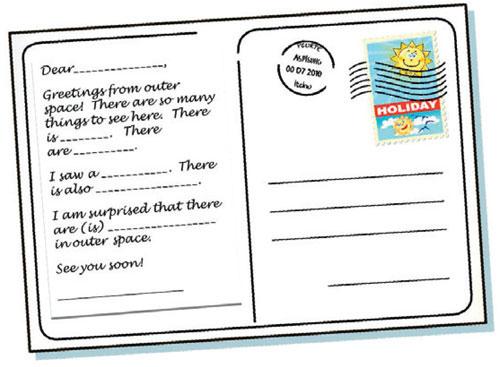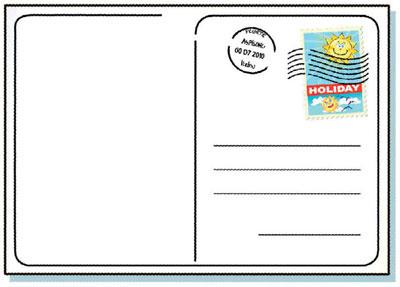Create To Communicate
LESSON 4
OUTER SPACE
To the Moon and Beyond!
Objective: Students will design the front of a postcard and write a letter on the back using present tense to be and past tense verbs.
Level: Beginner to Intermediate
Materials: Paper, pencils. Optional: paint, crayons, colored pencils, or markers.
Teacher Preparation: Duplicate the postcard template in the Reproducible Worksheet section.
Art Options: If paints are available, students can use paint in their outer space scenes. Have students use crayons to draw the items in their outer space artwork. Then have students use black tempera paint diluted with water or black watercolor paint to paint the background of the picture. The crayon drawings should resist being covered by the paint because of the wax in the crayons, creating a nice effect.
INSTRUCTIONS
Part One: Outer Space Landscape Drawing
- Discuss with students the various things they might see or encounter in outer space. Ask students questions such as:
What do you see when you look at the sky at night?
What do you imagine is out there?
Have you ever seen a movie or read a book about outer space? - Brainstorm ideas with students and create a list of outer space items on the board. If needed, introduce or review the outer space vocabulary that is generated. Refer to the vocabulary box on the right if necessary. Use the images at the end of the section to provide examples of the vocabulary words for students.
Outer Space Vocabularyouter space
meteor
UFO
star
moon
rocket ship
galaxy
alien
sun
planet
comet
shooting star - Tell students they are going to draw an outer space scene. They can include whatever outer space items they would like in their drawings, real or imaginary.
- Pass out paper and pencils to students. If possible, students can use crayons, markers, or colored pencils to add color to their outer space drawings.
- If appropriate for your students, discuss the idea of perspective. First demonstrate the concept by having a shorter student stand in the doorway of the classroom, and a taller student stand outside or down a long hallway. Who appears bigger? The student standing in the doorway should seem bigger, because he or she is standing closer. Similarly, some elements of a drawing may appear bigger and closer while others may look smaller or farther away.
- To show perspective, ask students to look at the images below (also provided in reproducible format at the end of this chapter) and decide with partners which aspects of each image appear closer and which appear farther away.
Part Two: Listening and Drawing
- Display students’ drawings around the room. Ask students to look at the outer space drawings their classmates created.
- Demonstrate the target structure (there is/there are) to students by using a student’s drawing as an example and giving students a few examples of things that can be seen in the drawing. For example: “There is a large planet in this outer space drawing,” or “There are many stars in this drawing.”
- Continue to review with students how there is/there are constructions are used with singular and plural nouns by demonstrating the structure with classroom items. For example, you might say:
There are ten desks in the classroom.
There are two bookshelves in the classroom.
There is one door in the classroom.
There is one stapler in the classroom.Ask students if they notice a pattern. When do you use there is and when do you use there are? - Have students practice using there is and there are by holding up a student’s painting and asking the other students to describe what they see.
- When students are comfortable with the structures there is and there are, have students play a listening and drawing game, as demonstrated below:
a. Break students up into small groups. Students can play the game with paper and pencil, or chalk and a chalkboard, or markers and a whiteboard.b. Tell the student who will draw to close his or her eyes.c. Once the student closes his or her eyes, choose an outer space drawing to describe.d. The other students in the group then take turns describing something that is in the drawing using there is or there are. For example: “There is a rocket ship shooting through the sky,” or “There are five shooting stars.” The student with closed eyes has to listen to the descriptions and try to draw what he or she hears.e. When students have finished describing the picture, students should compare the blind drawings to the original artwork.
Part Three: Outer Space Postcard
- For writing practice, have students write a postcard from outer space. Beginning level students can continue to practice the structure there is/there are, while intermediate level students can write a postcard in the past tense, describing what they saw, the things they encountered, or the places they went in the outer space trip.
- Students can use their drawings or their classmates’ drawings as motivation for what to write about.
- If necessary, review the structure of a postcard. A sample postcard is shown below. A blank postcard is also available at the end of this activity in the Reproducible Worksheets section.
Example

Part Four: Closing Activity
- When students are finished writing their postcards, display the outer space drawings on the classroom board or wall.
- Collect the postcards and mix them up.
- Hand each student a postcard.
- Have students take turns reading them. Students should try to guess which drawing the postcard describes.
- If desired, have students complete this activity in small groups. Hand out a few postcards to each group.
Extension Activities:
Planet/Star Descriptions News Report
Practice speaking or writing with higher level students by having students look at an outer space drawing created by a classmate and imagine that they have landed on one of the planets or stars depicted in the drawing. Ask students to describe to people on Earth what they see. Students can pretend they are giving a news report to people on Earth from outer space and focus on details such as the color of the sky above them, how many moons or suns they see, the air temperature, how the air feels, what they are going to do there, if there are any animals or other creatures, if there is water, and if there are plants.
Outer Space Word Search!
Use one of the online resources below to create a word search to review the outer space vocabulary used in this activity.
Discovery Education Puzzlemaker: http://www.puzzlemaker.discoveryeducation.com/
A to Z Teacher Stuff Word Search Worksheets: tools.atozteacherstuff.com
TeAchnology Word Search Maker: http://www.teach-nology.com/web_tools/word_search/
Additional Resources:
Students can learn more about outer space and astronomy on this website while also practicing English. This online resource has word searches, hangman games, outer space jokes, as well as many more outer space-related activities.
http://www.kidsastronomy.com/
http://www.kidsastronomy.com/
NASA’s kids’ website is a great resource for teachers and students. The site has videos, games, and online storybooks about outer space. Likewise, the site has an educator’s section with classroom activities, images of Earth and outer space, and downloadable posters and space podcasts.
http://spaceplace.nasa.gov/en/kids/
http://spaceplace.nasa.gov/en/kids/
PERSPECTIVE IMAGES
Directions: Compare and contrast the four images. Which aspects of the pictures look NEARER to you? Which look FARTHER away from you? Discuss with your partner.
SPACE IMAGES FOR ACTIVE IMAGINATION

WRITING FROM SPACE POSTCARD
Directions: Write a postcard from outer space to one of your classmates.